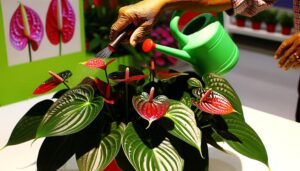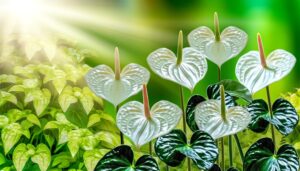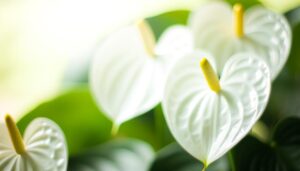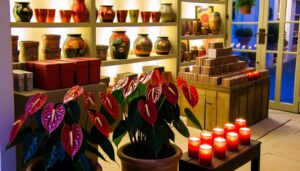Unique Traits of Anthurium Paris Black
You'll find the Anthurium Paris Black enchanting due to its deep black leaves, which owe their color to high anthocyanin concentrations. These pigments provide photoprotection, acting like sunscreen.
The leaves have a unique velvety texture, thanks to specialized epidermal cells and trichomes. Bright veins enhance light reflection, optimizing photosynthesis and attracting pollinators.
The distinct sagittate leaf shape furthers photosynthetic efficiency. This tropical plant prefers indirect, bright light, high humidity (60-80%), and temperatures between 65-80°F.
If you want to understand its growth habits and care requirements, there's much more to discover about this fascinating species.
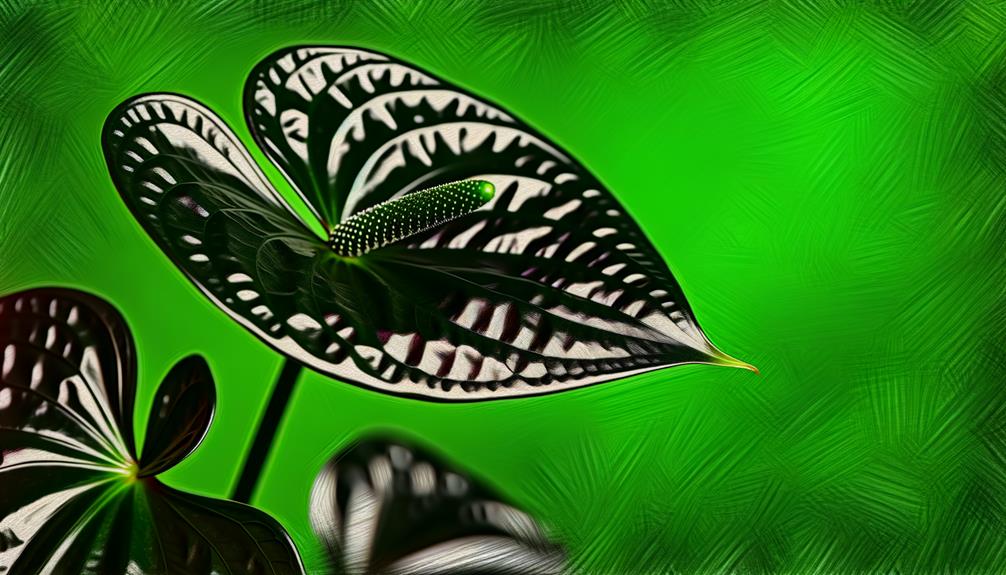
Key Takeaways
- Deep black leaves with high anthocyanin concentrations provide unique photoprotection and color.
- Velvety leaf texture results from specialized epidermal cells and trichomes.
- Bright veins enhance light reflection and photosynthesis while attracting pollinators.
- Distinct sagittate leaf shape optimizes photosynthetic efficiency and light absorption.
- Clumping and epiphytic growth habits allow dense clustering on tree branches in humid environments.
Deep Black Leaves
One of the most mesmerizing features of Anthurium Paris Black is its deep black leaves, which result from high concentrations of anthocyanins. You'll find these pigments, typically responsible for red, purple, and blue hues, create a unique black coloration by absorbing most visible light.
This phenomenon, known as pigment-mediated light absorption, gives the leaves their dramatic appearance. Anthurium Paris Black's ability to synthesize such high levels of anthocyanins not only makes it visually enchanting but also offers photoprotection. The anthocyanins act as a sunscreen, shielding the plant from excessive light and ultraviolet radiation.
This adaptation allows the plant to thrive in various light conditions while maintaining its stunning aesthetic. Understanding this feature enhances your appreciation of its botanical elegance.
Velvety Texture
Among the defining characteristics of Anthurium Paris Black, the velvety texture of its leaves stands out due to the presence of specialized epidermal cells that create a soft, tactile surface.
When you touch these leaves, you're actually feeling a dense layer of trichomes—tiny, hair-like structures that contribute to the plant's unique texture. These trichomes not only provide a luxurious feel but also play a role in minimizing water loss through transpiration.
As you run your fingers across the surface, you'll notice the perfect balance between softness and structural integrity, a reflection of the plant's evolutionary adaptation.
This velvety texture isn't just an aesthetic feature; it's a functional trait that enhances the plant's overall resilience and appeal.
Bright Veins
You'll notice that Anthurium Paris Black features bright veins that offer a striking contrast against its dark foliage. These veins enhance light reflection, giving the plant a unique luminescent quality.
Additionally, the vein color can vary, providing an extra layer of visual interest.
Contrasting Leaf Veins
The Anthurium Paris Black is distinguished by its striking bright veins, which sharply contrast against the dark, velvety leaves, enhancing its visual appeal and biological uniqueness.
These prominent veins aren't just aesthetically pleasing; they play a critical role in the plant's physiology. The chlorophyll-rich mesophyll tissues surrounding the veins optimize photosynthesis, while the xylem and phloem ensure efficient water and nutrient transportation.
The bright veins also function as a visual guide for pollinators, aiding in reproductive success. You'll find that this contrast accentuates the leaf structure, creating a dramatic visual impact.
It's this unique interplay between form and function that makes the Anthurium Paris Black an exceptional specimen for any collection.
Enhanced Light Reflection
In addition to their role in physiology and aesthetics, the bright veins of Anthurium Paris Black enhance light reflection, maximizing the plant's ability to capture and utilize available light for photosynthesis.
These prominent veins act as natural reflectors, redirecting photons to chloroplast-rich regions. By optimizing light distribution, they facilitate efficient energy conversion, boosting the plant's overall photosynthetic rate.
You'll appreciate the scientific elegance of this adaptation, as it not only supports robust growth but also contributes to the plant's striking visual appeal.
The reflective properties of the veins guarantee that even in suboptimal lighting conditions, the Anthurium Paris Black efficiently harnesses light, highlighting its evolutionary prowess in adapting to diverse environments.
Vein Color Variations
Bright veins in Anthurium Paris Black exhibit a fascinating range of color variations, from striking whites to vivid reds, each contributing uniquely to the plant's physiological processes and aesthetic appeal.
These chromatic differences enhance photosynthetic efficiency by improving light absorption and reflectance. You'll notice that the red veins, rich in anthocyanins, provide photoprotection by filtering excessive light, thus averting photodamage.
On the other hand, the white veins, high in reflective pigments, maximize internal light distribution, ensuring ideal chloroplast function. These variations not only enhance the plant's visual allure but also signify adaptive strategies to diverse light environments.
Understanding these intricate vein color dynamics offers you deeper insights into the Anthurium Paris Black's remarkable adaptability and resilience.
Unique Leaf Shape
Anthurium Paris Black displays a distinctive sagittate leaf shape, characterized by its elongated, heart-like form with pointed lobes and a pronounced sinus. You'll notice how the leaf blades extend gracefully, tapering to acute apices that emphasize their unique morphology. The petiole attaches at the sinus, creating a striking contrast between the leaf's broad base and its narrowing tip.
This specific leaf shape optimizes photosynthetic efficiency by maximizing surface area while minimizing overlap. The glossy, velvety texture enhances light absorption, contributing to the plant's overall importance. Additionally, the pronounced venation reinforces the structural integrity of the leaves, allowing them to support their own weight and resist damage from environmental stressors.
You can appreciate how these intricate features set Anthurium Paris Black apart.
Growth Habits
Observing its unique leaf shape, you'll also be intrigued by the Anthurium Paris Black's distinctive growth habits, characterized by its clumping nature and epiphytic tendencies. This plant thrives in humid environments, often anchoring itself to tree branches. Its aerial roots, designed to absorb moisture and nutrients from the air, highlight its adaptability.
You'll notice it forms dense clusters, promoting a robust root system that supports vertical growth. The Anthurium Paris Black grows slowly but steadily, requiring minimal soil. It favors well-drained substrates like orchid bark or sphagnum moss. By mimicking its natural habitat, you're ensuring ideal health.
Monitoring humidity levels and providing adequate airflow will further enhance its growth, allowing this unique specimen to flourish in your care.
Light Requirements
Securing ideal growth for Anthurium Paris Black involves providing it with indirect, filtered light to replicate its natural understory habitat. You should place it where it receives bright, diffused light, avoiding direct sunlight that can scorch its delicate leaves. Aim for a location with dappled light or use sheer curtains to soften intense rays.
Consistent exposure to moderate light levels ensures prime photosynthesis without causing photodamage. Monitor the leaf coloration; if they turn yellow, it indicates excessive light, while dark green leaves may suggest insufficient light. By carefully adjusting light conditions, you'll promote robust growth and vibrant foliage, enhancing the plant's ornamental appeal.
Watering Needs
To maintain best moisture levels for Anthurium Paris Black, you need to establish a consistent watering schedule. Guarantee the substrate remains evenly moist, but avoid waterlogging to prevent root rot.
Adequate drainage is essential, so use a well-aerated potting mix to facilitate proper water flow.
Optimal Moisture Levels
Maintaining ideal moisture levels for Anthurium Paris Black is imperative, requiring a consistent watering schedule that prevents both waterlogging and drought. You need to aim for a soil moisture level that's evenly moist but not saturated.
Utilize a well-draining potting mix containing peat, perlite, and orchid bark to optimize aeration and moisture retention.
Employ a moisture meter to monitor soil hydration, ensuring it remains in the moderate range, typically between 40-60% soil moisture content. Avoid letting the soil dry out completely, as this can induce stress and hinder growth.
Conversely, refrain from overwatering, which can lead to root rot. Your goal is to strike a balance that maintains the plant's health and strength.
Consistent Watering Schedule
Establishing a consistent watering schedule for Anthurium Paris Black involves careful monitoring and precise timing to align with the plant's moisture requirements. You'll need to maintain a balance between hydration and overwatering.
Monitor the soil's moisture level frequently, verifying it's evenly moist but not saturated. Employ a systematic approach:
- Utilize a moisture meter: This tool provides accurate readings of soil moisture levels.
- Observe leaf behavior: Wilting or yellowing leaves can indicate the need for water adjustment.
- Water in the morning: This timing ensures evaporation and absorption synchronize with the plant's natural rhythms.
Drainage and Avoid Overwatering
Ensuring proper drainage is vital to prevent overwatering and root rot in Anthurium Paris Black. You should use a well-aerated, porous potting mix, rich in organic matter. Incorporate materials like perlite, orchid bark, and sphagnum moss to enhance drainage.
Make sure your pot has ample drainage holes to facilitate excess water escape. Avoid using saucers that hold water, as stagnant moisture promotes root rot. Water your Anthurium when the top inch of soil feels dry; overwatering can suffocate roots and lead to fungal infections. Consistently monitor moisture levels with a hygrometer.
If you notice yellowing leaves or mushy roots, reassess your watering practice immediately. Proper drainage and mindful watering are essential to maintaining your Anthurium's vibrant health.
Soil Preferences
Selecting the right soil mix for Anthurium Paris Black is crucial for promoting ideal root health and growth. You'll want to aim for a well-draining, aerated substrate that mimics its natural epiphytic environment. A balanced mixture facilitates nutrient uptake and prevents root rot.
Consider incorporating the following components:
- Pine Bark: Enhances aeration and promotes root development.
- Perlite: Boosts drainage, preventing water logging.
- Sphagnum Moss: Retains moisture without compromising air circulation.
These elements optimize the substrate remains light yet retains necessary moisture. Avoid heavy, compact soils that can suffocate the roots and impede growth.
Regularly check for compaction and refresh the mix as needed. By maintaining an ideal soil environment, you'll support the thriving, lush foliage that makes Anthurium Paris Black so distinctive.
Humidity Levels
Maintaining ideal moisture levels is essential for the healthy growth of Anthurium Paris Black, as this tropical plant thrives in environments with 60-80% humidity. You'll want to monitor ambient dampness diligently, using a hygrometer for accurate readings.
If levels drop below the best range, employ a humidifier to elevate humidity or place the plant on a tray filled with water and pebbles. Misting can provide short-term relief but isn't a long-term solution. Ensure air circulation remains sufficient to prevent fungal issues.
In low-humidity conditions, leaf edges may brown, indicating stress. Consistent moisture supports vibrant foliage and overall vigor. Prioritize maintaining these conditions to nurture your Anthurium Paris Black to its fullest potential.
Temperature Range
You need to maintain a temperature range between 20°C and 30°C for best growth of Anthurium Paris Black.
It's important to monitor for cold sensitivity, as temperatures below 15°C can cause significant stress.
Watch for indicators such as leaf discoloration and reduced growth, which signal temperature stress.
Optimal Growing Conditions
For Anthurium Paris Black to thrive, maintaining a temperature range between 65°F and 80°F is crucial. This specific range promotes optimal enzymatic activity and cellular respiration, fostering robust growth. You'll need to monitor ambient conditions closely to avoid deviations that could stress the plant.
Key considerations include:
- Consistent Temperatures: Fluctuations can disrupt metabolic processes.
- Humidity Control: Aim for 70-80% relative humidity to mimic its native tropical environment.
- Air Circulation: Ensure proper ventilation to prevent fungal infections while sustaining humidity levels.
Cold Sensitivity Concerns
Cold sensitivity in Anthurium Paris Black manifests when temperatures drop below 55°F, leading to impaired physiological functions and potential cellular damage. You'll notice that this tropical plant's metabolic activities decelerate, disrupting nutrient absorption and photosynthesis. Chilling injury, a phenomenon where cellular membranes lose integrity, can occur, causing irreversible harm.
Maintaining an ideal thermal environment is vital. Guarantee ambient temperatures remain within the 60-80°F range to prevent stress. Sudden temperature fluctuations exacerbate cold sensitivity, making it essential to avoid drafts and cold windowsills.
Employing a digital thermometer for continuous monitoring can help you sustain ideal conditions. By understanding these sensitivities, you'll optimize your Anthurium Paris Black thrives, showcasing its unique elegance without succumbing to cold-induced stress.
Temperature Stress Indicators
Temperature stress indicators in Anthurium Paris Black become evident through symptoms like leaf discoloration, wilting, and stunted growth when the plant is exposed to non-ideal thermal conditions. You'll notice these signs when the temperature deviates from the preferred range of 18-27°C (64-81°F).
To maintain peak health for your Anthurium Paris Black, you should monitor for:
- Leaf discoloration: Yellowing or browning of leaves indicates thermal stress.
- Wilting: Droopy, limp leaves suggest the plant is too hot or too cold.
- Stunted growth: Slower development or smaller leaves signal prolonged exposure to improper temperatures.
Display Ideas
When deciding on how to display your Anthurium Paris Black, consider using a minimalist planter to highlight its unique foliage and striking black spathes. Opt for a white or neutral-colored pot to create contrast and draw attention to the plant's intricate details. Positioning is critical; place it in a well-lit area, avoiding direct sunlight to prevent leaf scorch.
| Display Aspect | Recommendation | Rationale |
|---|---|---|
| Planter Choice | Minimalist, neutral-colored | Enhances visual contrast |
| Light Positioning | Indirect, bright light | Prevents leaf damage, promotes growth |
| Placement Location | Eye-level, focal point | Maximizes aesthetic impact and visibility |
Common Challenges
Caring for an Anthurium Paris Black involves addressing common challenges such as pest infestation, root rot, and nutrient deficiencies. You'll need to monitor your plant closely to prevent these issues from escalating.
- Pest Infestation: Use neem oil or insecticidal soap to combat aphids, mites, and mealybugs.
- Root Rot: Maintain proper drainage by using a well-aerated substrate and avoid overwatering.
- Nutrient Deficiencies: Apply a balanced fertilizer to provide essential macro and micronutrients.
Regularly inspect leaves for discoloration or deformities, as these can be early indicators of underlying problems.
Maintain ideal humidity levels around 60-80%, and make sure your Anthurium receives indirect, bright light.
Conclusion
Caring for an Anthurium Paris Black is like maintaining a classic car—meticulous attention to detail yields stunning results. With its deep black leaves, velvety texture, and bright veins, this plant demands specific humidity and temperature conditions.
Imagine ensuring the right fuel mix for peak performance; similarly, you need to balance these factors for your Anthurium. By understanding its unique traits and growth habits, you can cultivate a botanical masterpiece that truly stands out.

